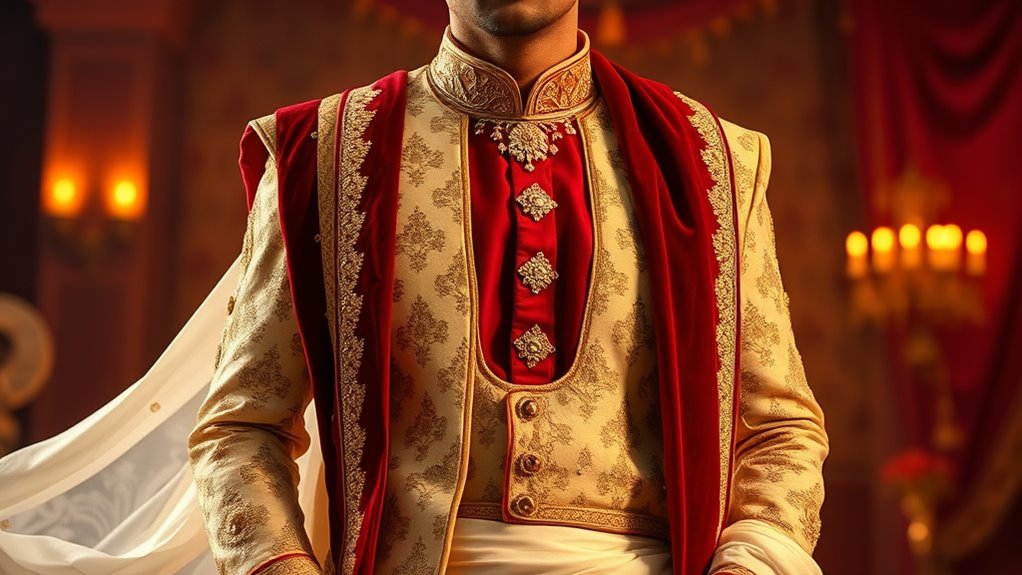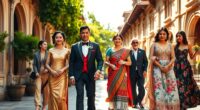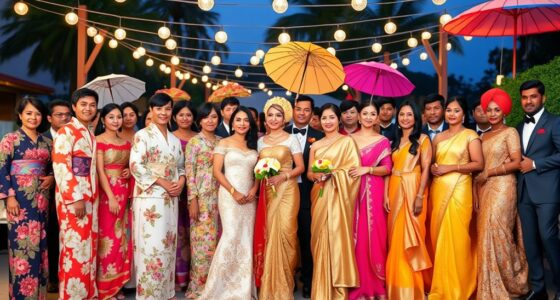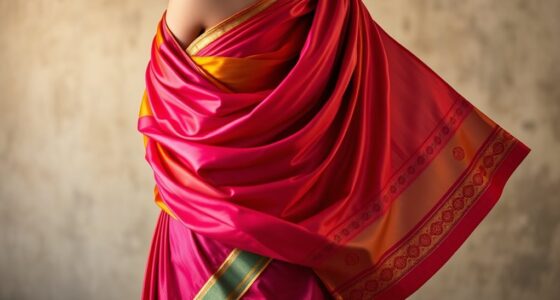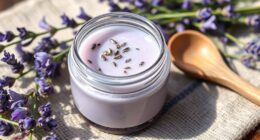Traditional Indian menswear includes the regal sherwani, versatile kurta, and classic dhoti, each with a rich history rooted in Mughal nobility and regional culture. The sherwani symbolizes royalty, while kurtas vary in style across India’s regions, and dhotis reflect cultural pride and tradition. To incorporate these into modern wardrobes, you can mix traditional fabrics with contemporary accessories. Discover more about how these timeless garments blend history and style seamlessly.
Key Takeaways
- Sherwani is a regal, Mughal-origin coat symbolizing nobility, often embellished with embroidery and worn at weddings and formal events.
- Kurta is a versatile traditional tunic with regional styles, fabrics, and embroidery, suitable for both casual and festive occasions.
- Dhoti is a classic rectangular cloth wrapped around the waist and legs, representing cultural pride and worn during ceremonies and festivals.
- Modern styling combines traditional garments with contemporary accessories, fabrics, and fusion outfits for special occasions and daily wear.
- Incorporating these traditional pieces into contemporary wardrobes enhances cultural expression while maintaining modern fashion sensibilities.
The Origins and Cultural Significance of the Sherwani
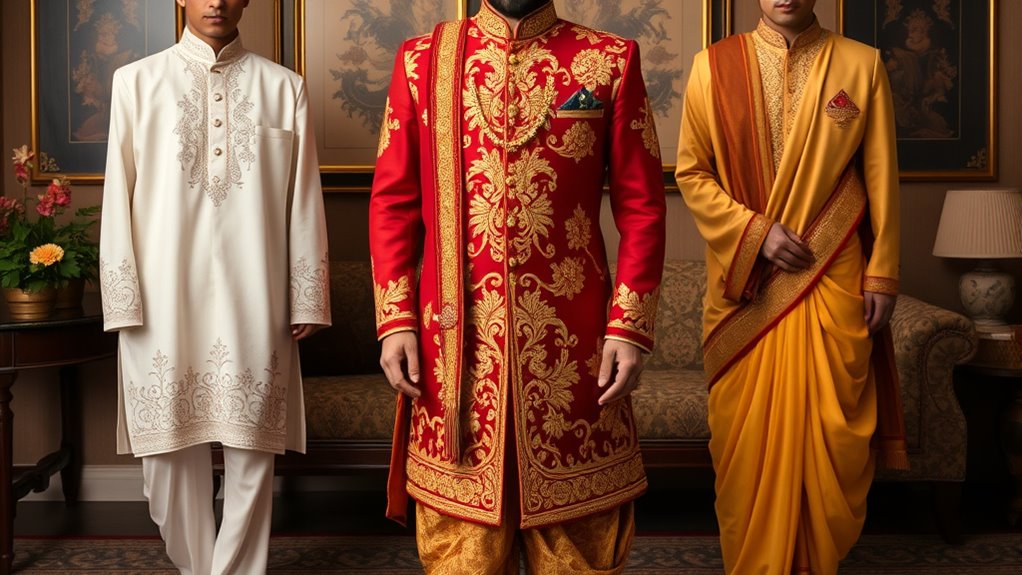
The sherwani has a rich history rooted in Mughal India, where it served as a symbol of nobility and regal authority. Its historical evolution reflects a blend of cultural influences, evolving from Persian and Central Asian attire into a distinct Indian garment. Over time, regional influences shaped its design, with different areas adding unique embroidery, fabrics, and embellishments. During the Mughal era, it became a mark of aristocracy, worn by royalty and courtiers alike. As centuries passed, the sherwani retained its regal status while adapting to local tastes and traditions. Today, its cultural significance remains strong, symbolizing dignity and tradition in Indian celebrations. The garment’s history demonstrates how regional influences and historical evolution contributed to its status as a timeless symbol of Indian masculinity. Its design elements continue to reflect a rich tapestry of cultural heritage, making it a cherished attire for special occasions.
Styles and Variations of the Kurta Across Regions
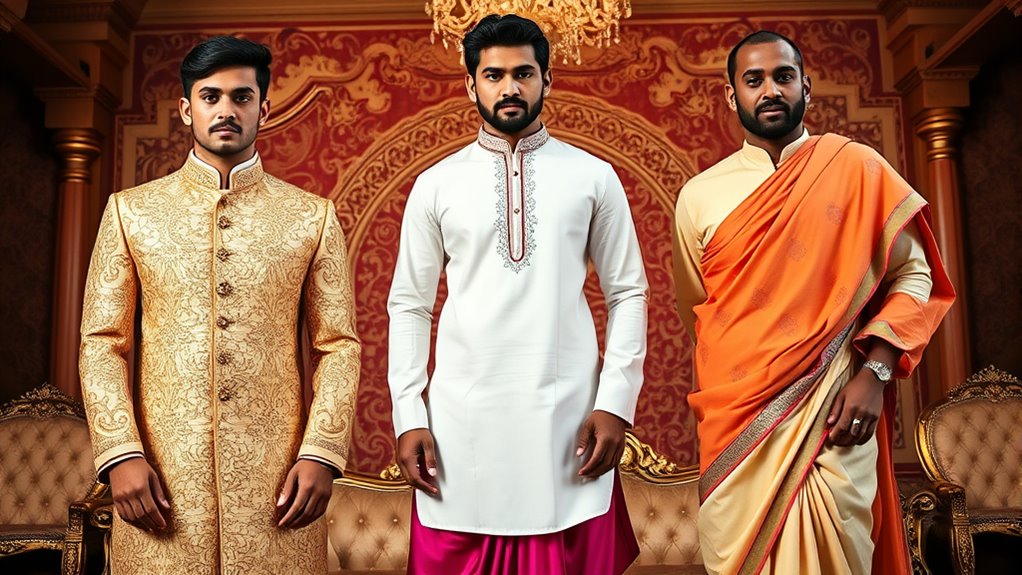
Across India, the kurta showcases a diverse range of styles and variations that reflect regional traditions and cultural identities. In North India, you’ll find longer kurtas made from cotton or silk, often embroidered for festive occasions. South Indian styles favor lighter fabrics like linen and cotton, with simpler cuts suited for warm climates. In Punjab, you might wear a kurta with a straight cut and vibrant colors, while in Bengal, the kurta often features intricate hand embroidery and softer fabrics. Regional variations also influence fabric choices—Kashmir favors luxurious brocades, while Rajasthan prefers lightweight, breathable materials. Additionally, regional fashion preferences influence the choice of accessories and pairing styles, further emphasizing local cultural expressions. These differences highlight how regional traditions shape the kurta’s style and fabric, allowing you to express cultural heritage through your attire.
The Traditional Attire: Dhoti and Its Cultural Roots

Moving from the colorful and varied styles of kurtas, traditional Indian menswear also features the dhoti, a garment with deep cultural roots. The dhoti is a rectangular piece of cloth wrapped around your waist and legs, often tied securely for comfort and ease of movement. It’s especially popular during festive occasions, symbolizing tradition and cultural pride. Regional variations influence how you wear the dhoti, with different styles seen across India—some drape it more elaborately, others keep it simple. Historically, it’s associated with both rural and urban settings, representing humility and elegance. Today, the dhoti remains a essential part of ceremonial dress, connecting you to India’s rich cultural heritage and diverse regional customs. Additionally, understanding self-watering plant pots can offer insights into traditional practices of sustainability and resourcefulness that are often reflected in Indian textiles and attire.
How to Wear and Style These Garments for Modern Occasions
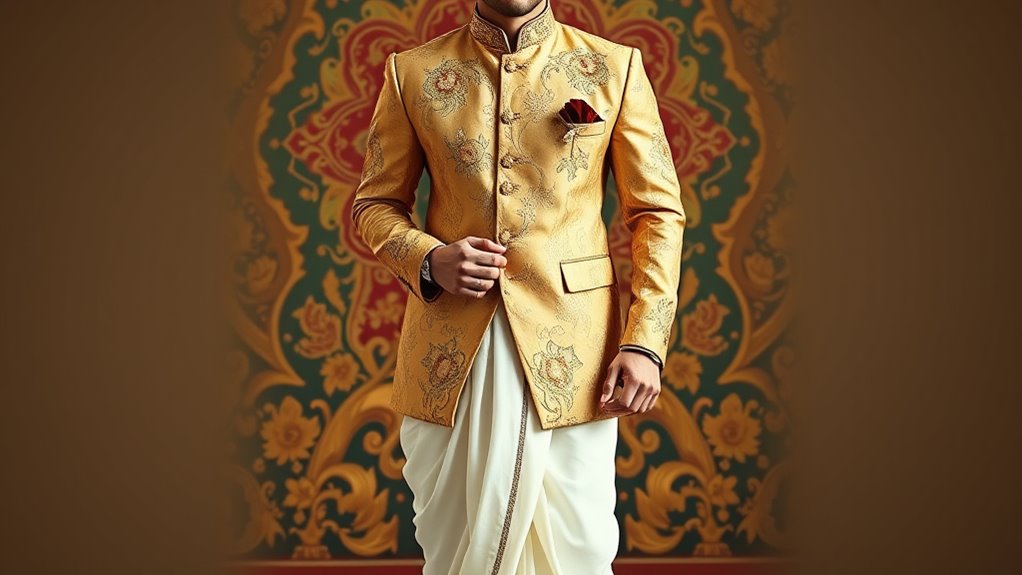
To incorporate traditional Indian menswear into modern occasions, you can adapt classic garments like the kurta and dhoti with contemporary accessories and styling techniques. For festive occasions, choose a well-fitted kurta in luxe fabrics like silk or brocade, pairing it with modern accessories such as sleek watches or minimalist footwear. Roll up the dhoti slightly for a relaxed, stylish look or pair it with a tailored shirt for a fusion vibe. Keep accessories subtle yet elegant, like a simple chain or a pocket square, to modernize your appearance. Remember, the key is balancing tradition with contemporary flair, so avoid overly ornate jewelry or accessories that may seem out of place. With the right styling, these garments become versatile for any modern festive occasion.
Tips for Incorporating Traditional Indian Menswear Into Contemporary Wardrobes
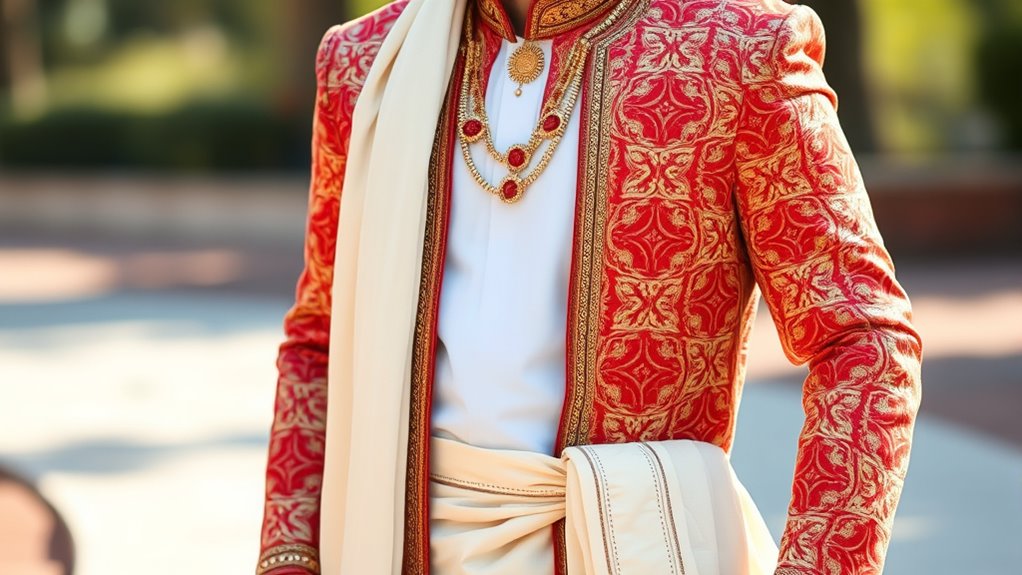
Incorporating traditional Indian menswear into your modern wardrobe is all about blending classic elements with contemporary style. Start by choosing versatile pieces like a well-fitted kurta or sherwani that can be dressed up or down. When accessorizing outfits, opt for subtle jewelry or modern footwear to add a contemporary touch. Pay attention to fabric choices—lighter, breathable fabrics like cotton or linen work well for everyday wear, while silk or brocade can elevate your look for special occasions. Mix and match traditional garments with modern staples like jeans or chinos for a balanced look. Keep accessories minimal and modern, so your outfit feels fresh yet rooted in tradition. This approach helps you seamlessly incorporate Indian menswear into your everyday wardrobe. Additionally, understanding halal fashion trends can inspire you to incorporate modest and culturally resonant elements into your style.
Frequently Asked Questions
What Fabrics Are Most Commonly Used in Traditional Indian Menswear?
When choosing fabrics for traditional Indian menswear, you’ll find silk embroidery is popular for its rich, luxurious feel, perfect for festive occasions. Cotton offers comfort and breathability, making it ideal for daily wear or warmer climates. You might also consider brocade or velvet for added elegance. The fabric choice depends on the event and your comfort, so mix and match to create a look that’s both stylish and comfortable.
How Do Regional Climates Influence Garment Styles and Fabrics?
You’ll notice that regional climates greatly influence garment styles and fabrics in Indian menswear. In hotter areas, you prefer lightweight, breathable fabrics like cotton and linen for comfort during warm seasons. Conversely, cooler regions call for heavier, insulating materials such as wool and silk. These seasonal fabric choices are adaptations to regional climate variations, ensuring you stay comfortable year-round while maintaining traditional styles suited to your environment.
Are There Specific Accessories That Complement Sherwani, Kurta, or Dhoti?
You can enhance your look by choosing specific accessories for sherwani, kurta, or dhoti. Sherwani accessories like brooches, turbans, or embellished buttons add elegance, while kurta embellishments such as embroidery, beads, or metallic accents bring vibrancy. For dhoti styling, consider traditional items like waistbands or shawls. These accessories and embellishments help you create a polished, culturally rich appearance that complements each garment beautifully.
How Has Modern Fashion Influenced Traditional Indian Menswear Designs?
While traditional Indian menswear maintains its timeless appeal, modern fashion’s fusion trends and designer influences reshape its look. You’ll notice contemporary cuts, fabrics, and styles blending seamlessly with classic elements, creating a fresh, versatile aesthetic. This integration allows you to honor cultural roots while embracing innovation. As a result, traditional pieces become more adaptable, appealing to diverse tastes and occasions, reflecting a dynamic evolution driven by global fashion influences.
What Occasions Are Most Appropriate for Wearing Traditional Indian Menswear?
You should wear traditional Indian menswear during significant occasions like weddings, festivals, and cultural ceremonies, as these garments hold deep cultural significance. Their historical evolution reflects rich heritage and respect for tradition. Wearing them shows appreciation for cultural roots and honors the occasion’s importance. Whether it’s a sherwani at a wedding or a kurta during festivals, these outfits connect you to India’s vibrant history and celebrate its timeless traditions.
Conclusion
Embracing traditional Indian menswear isn’t just about clothing; it’s about honoring a rich heritage that weaves history and culture into every stitch. Whether you choose a sherwani, kurta, or dhoti, these garments connect you to centuries of tradition. Remember, style isn’t just what you wear—it’s a story you tell. So, wear your heritage proudly and let your attire speak volumes, turning every moment into a celebration of timeless elegance.
